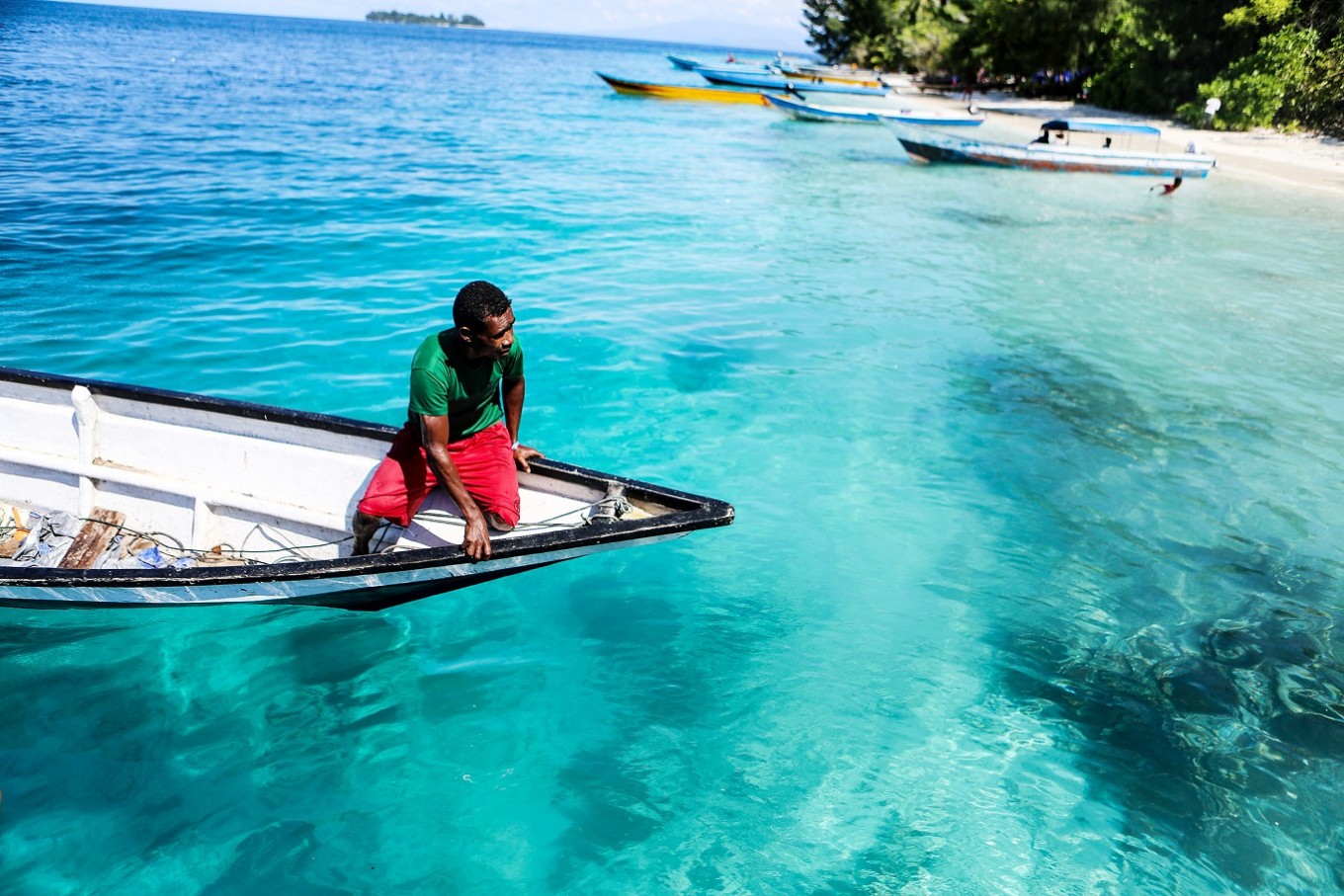Saving Raja Ampat waters with tourism
A local initiative in Raja Ampat, West Papua, is finding a solution for how to conserve nature through tourism.
Change Size
 See-through sea: A fisherman tries to reach the shore of one of the Fam Islands. (JP/Seto Wardhana)
See-through sea: A fisherman tries to reach the shore of one of the Fam Islands. (JP/Seto Wardhana)
E
nvironmentalists and academics estimate that Indonesia might suffer losses of US$18.6 million from damage to coral reefs in Raja Ampat, West Papua, caused by the Caledonian Sky cruise ship earlier this month.
Conservation International Indonesia (CII), Papua State University and the Regional Technical Implementing Unit (UPTD) conducted research to analyze the damage to the coral reefs.
Ricardo Tapilatu, who headed the research, said that several endemic reefs that were unique to that part of the world were damaged.
“The types of reefs that were damaged by the ship are Genus Porites, Acropora, Poicilopora, Tubastrea, Montipora, Stylopora, Favia and Pavites. It will take decades to restore the reefs,” he said on Monday.
He added that the damaged area reached 13,532.60 square meters and was estimated to cause losses of $18.6 million.
CII spokesman, Albert Nebore, said the cruise ship allegedly entered the area without consulting local guides. He added that the ship’s crew only relied on GPS without considering the tide.
“The skipper forced the ship to enter the area, which was not open to cruise ships,” he said.
(Read also: Ministry to check damage to Raja Ampat coral reefs)
Indonesia’s Environment and Forestry Ministry sent staff to identify the damaged coral reefs and to collect evidence to use later to demand compensation from the travel company Noble Caledonia, which operated the cruise.
Ministry spokesman Djati Witjaksono said, “we will discuss with experts the amount of compensation the company must pay [to Indonesia].”
The 90-meter Caledonian Sky cruise ship — which weighs 4,200 tons and carried 102 passengers — entered the Dampir Strait in the maritime conservation site in Raja Ampat on March 4. It sailed from Papua New Guinea to the Philippines.

The world-famous diving site has been proposed by the Indonesian government as a United Nations Educational Scientific and Cultural Organization (UNESCO) world heritage site.
Head of Raja Ampat Professional Divers organization, Ruben Sauyai, said the coral reefs had been badly damaged.
“The area is a popular diving spot for tourists because it has lots of beautiful coral. Now, I am afraid we cannot take tourists here because nothing is left due to the incident,” he said.
Ruben hoped the government would draft regulations on prohibiting cruise ships for entering sensitive areas, like the Dampir Strait, to prevent similar incidents from happening in the future.
Coral reef expert from the Indonesian Coral Reef Foundation, Safran, said if the government received the compensation, it must be used to rehabilitate the reefs.
(Read also: Scientists race to prevent wipeout of world's coral reefs)
“The reefs should be carefully observed during the first year of planting because the coral could easily die in the first year,” he said.
The British Embassy in Jakarta expressed its position on this problem. Faye Belnis from the embassy said they were aware of the report and hoped that the local authorities and the travel company could resolve the problem as soon as possible.
The British-owned company described the incident as “unfortunate” and said it was “cooperating fully with the relevant authorities”, the Guardian reported.
National Police spokesman Sr. Comr. Martinus Sitompul said the police would wait for instruction from related parties before taking action. He added that the police could investigate the case by using the Environment Protection and Management Law.
In a statement sent to The Jakarta Post on Monday night, Noble Caledonia, the operator of Caledonian Sky, said that the company and their insurers would be working with the government and specialists to come to an agreement in relation to the damage to the reef.
“The company is firmly committed to the protection of the environment and as such deeply regrets any damaged caused to the reef,” it states.

The communities on the Fam Islands and Mayalibit Bay, Raja Ampat regency, West Papua, seem to believe in the idea of nurturing Mother Earth instead of destroying her as conservation efforts will bring so much more to the people.
Once a nickel mining area, Raja Ampat did not seem to have a future. The local communities realized that they could not go far with this industry. Once the reserves were gone, there was nothing they could do.
(Read also: What to do in Raja Ampat beyond diving, snorkeling)
American environmental organization Conservation International then came up with an idea to develop the local economy through tourism.
Since 2004, the organization has been promoting tourism as a promising industry for Raja Ampat. Under its program, Conservation International has been trying to convince central and regional governments to build the local economy through tourism and fisheries rather than mining.
In another recent breakthrough, the organization managed to convince Raja Ampat regency and the people from the Fam Islands, Saukabu and Saupapir villages to declare their waters a traditional conservation zone last month.

This acknowledgment of the territory, called the Network of Seascape Conservation Zones, is another big success for Conservation International to change Raja Ampat from being a nickel mining center, as its previous economic pillar, into a worldclass tourist destination.
In addition to the Fam Islands, Saukabu and Saupapir villages, the community of Mayalibit Bay has also declared a similar zone in their 53,100-hectare area that includes Piaynemo Island — a major tourist spot for enjoying the scenic island group.
“If we wish to manage the sea properly in order to produce maritime economic gains over the long term through biodiversity, fisheries and environmental services, it should be designed in a network of marine conservation zones so as to offer longterm ecological and economic functions in a very effective way,” said the vice president of Conservation International, Ketut Sarjana Putra.

The traditional conservation zones are meant to prevent over-fishing and unsustainable catching practices using poisons and explosives, as well as to determine harvest opening and ending times for local fishermen. However, such customary rules are inadequate. The abundant fish stocks in Raja Ampat waters have made the region a target for illegal fishing. Therefore, a surveillance system set up by the authorities is also needed.
A recent incident of a cruise ship smashed into and destroyed coral reefs in Raja Ampat is believed to be caused by the lack of monitoring and coordination among local authorities.
Despite the importance of the zones and its surveillance system , the local government has not yet recognized.
“So far no regulation has yet been issued to recognize their ownership rights to the communal property,” said Raja Ampat Regent Abdul Faris Umlati.
The local communities’ declarations in Raja Ampat won’t be observed as they should be unless the local government gives its recognition in a binding regulation.
The recognition of the zones by the local government will maximize the protection of sea biodiversity and the environment, which is expected to attract more tourists to the region.
About 15,000 tourists (including 6,000 domestic vacationers) visited Raja Ampat in 2016. Foreign tourists must pay Rp 1 million (US$74.72) and local visitors Rp 500,000 in levies to visit the Raja Ampat territory.
Despite the figures, the region still suffered a deficit of at least $1.4 million annually on average for monitoring the area.
Income from tourist visits is expected to meet the deficit from the surveillance costs for the traditional conservation zones.
Therefore, several nongovernmental organizations like Conservation International, the World Wildlife Fund and the Nature Conservancy strive to cover the shortage by forming a perpetual fund called the Blue Abadi Fund. So far, they have collected $23 million of their target of $38 million from donors, philanthropists and central and regional governments.
But water conservation is not sufficient without land protection.
“Indonesia will never succeed in managing its waters without seriously protecting its landscape as well,” indicated Ketut. According to him, gorgeous marine zones with their lavish features of biodiversity will certainly attract increasing numbers of tourists and coral reefs will continue thriving if forests are well maintained.
This year, with a planned ferry service and a direct flight from Manado by Wings Air, the total number of tourists is expected to reach 20,000.






